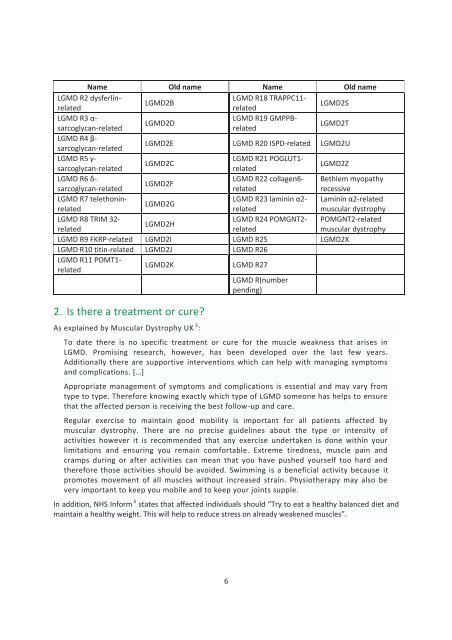You also want an ePaper? Increase the reach of your titles
YUMPU automatically turns print PDFs into web optimized ePapers that Google loves.
Name Old name Name Old name<br />
<strong>LGMD</strong> R2 dysferlinrelated<br />
related<br />
<strong>LGMD</strong> R18 TRAPPC11-<br />
<strong>LGMD</strong>2B<br />
<strong>LGMD</strong>2S<br />
<strong>LGMD</strong> R3 α-<br />
<strong>LGMD</strong> R19 GMPPBrelated<br />
<strong>LGMD</strong>2D<br />
sarcoglycan-related<br />
<strong>LGMD</strong>2T<br />
<strong>LGMD</strong> R4 β-<br />
sarcoglycan-related<br />
<strong>LGMD</strong>2E <strong>LGMD</strong> R20 ISPD-related <strong>LGMD</strong>2U<br />
<strong>LGMD</strong> R5 γ-<br />
<strong>LGMD</strong> R21 POGLUT1-<br />
<strong>LGMD</strong>2C<br />
sarcoglycan-related<br />
related<br />
<strong>LGMD</strong>2Z<br />
<strong>LGMD</strong> R6 δ-<br />
<strong>LGMD</strong> R22 collagen6- Bethlem myopathy<br />
<strong>LGMD</strong>2F<br />
sarcoglycan-related<br />
related<br />
recessive<br />
<strong>LGMD</strong> R7 telethoninrelated<br />
related<br />
muscular dystrophy<br />
<strong>LGMD</strong> R23 laminin α2- Laminin α2-related<br />
<strong>LGMD</strong>2G<br />
<strong>LGMD</strong> R8 TRIM 32-<br />
<strong>LGMD</strong> R24 POMGNT2- POMGNT2-related<br />
<strong>LGMD</strong>2H<br />
related<br />
related<br />
muscular dystrophy<br />
<strong>LGMD</strong> R9 FKRP-related <strong>LGMD</strong>2I <strong>LGMD</strong> R25 <strong>LGMD</strong>2X<br />
<strong>LGMD</strong> R10 titin-related <strong>LGMD</strong>2J <strong>LGMD</strong> R26<br />
<strong>LGMD</strong> R11 POMT1-<br />
related<br />
<strong>LGMD</strong>2K<br />
<strong>LGMD</strong> R27<br />
<strong>LGMD</strong> R(number<br />
pending)<br />
2. Is there a treatment or cure?<br />
As explained by Muscular Dystrophy UK 3 :<br />
To date there is no specific treatment or cure for the muscle weakness that arises in<br />
<strong>LGMD</strong>. Promising research, however, has been developed over the last few years.<br />
Additionally there are supportive interventions which can help with managing symptoms<br />
and complications. *…+<br />
Appropriate management of symptoms and complications is essential and may vary from<br />
type to type. Therefore knowing exactly which type of <strong>LGMD</strong> someone has helps to ensure<br />
that the affected person is receiving the best follow-up and care.<br />
Regular exercise to maintain good mobility is important for all patients affected by<br />
muscular dystrophy. There are no precise guidelines about the type or intensity of<br />
activities however it is recommended that any exercise undertaken is done within your<br />
limitations and ensuring you remain comfortable. Extreme tiredness, muscle pain and<br />
cramps during or after activities can mean that you have pushed yourself too hard and<br />
therefore those activities should be avoided. Swimming is a beneficial activity because it<br />
promotes movement of all muscles without increased strain. Physiotherapy may also be<br />
very important to keep you mobile and to keep your joints supple.<br />
In addition, NHS Inform 5 states that affected individuals should “Try to eat a healthy balanced diet and<br />
maintain a healthy weight. This will help to reduce stress on already weakened muscles”.<br />
6

















